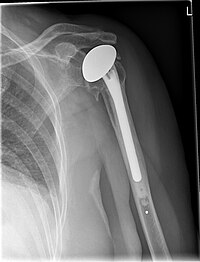
Photo from wikipedia
Introduction The objective of this study was to quantitatively evaluate the effects of daily teriparatide on rheumatoid arthritis patients using predicted bone strength (PBS) assessed by quantitative computed tomography-based finite-element… Click to show full abstract
Introduction The objective of this study was to quantitatively evaluate the effects of daily teriparatide on rheumatoid arthritis patients using predicted bone strength (PBS) assessed by quantitative computed tomography-based finite-element analysis (QCT/FEA) and using bone mineral density (BMD) assessed by dual-energy X-ray absorptiometry (DXA), and to prospectively investigate clinical determinants associated with PBS and BMD increases. Materials and Methods Participants comprised 39 patients (mean age, 69 years; disease activity score assessing 28 joints with CRP, 3.0; previous vertebral fractures, 82%) enrolled in this study. BMD by DXA and PBS by QCT/FEA of lumbar spine (LS) and proximal femur were measured at baseline, and after 6 and 12 months. In the groups showing increases in these values, variables that may have affected these increases were evaluated using univariate logistic regression analysis. Results Daily teriparatide treatment significantly increased not only LS BMD, but also LS PBS in RA patients with osteoporosis after both 6 and 12 months of treatment. Increases in N-terminal type I procollagen propeptide (PINP) at 1 and 3 months were significantly associated with increased LS PBS at 12 months according to univariate logistic regression analysis. The threshold value for increased PINP at 1 month for increased PBS at 12 months was 75 µg/L. Conclusions Increased LS PBS at 12 months was predicted by increased PINP at 1 month from baseline.
Journal Title: Journal of Bone and Mineral Metabolism
Year Published: 2020
Link to full text (if available)
Share on Social Media: Sign Up to like & get
recommendations!